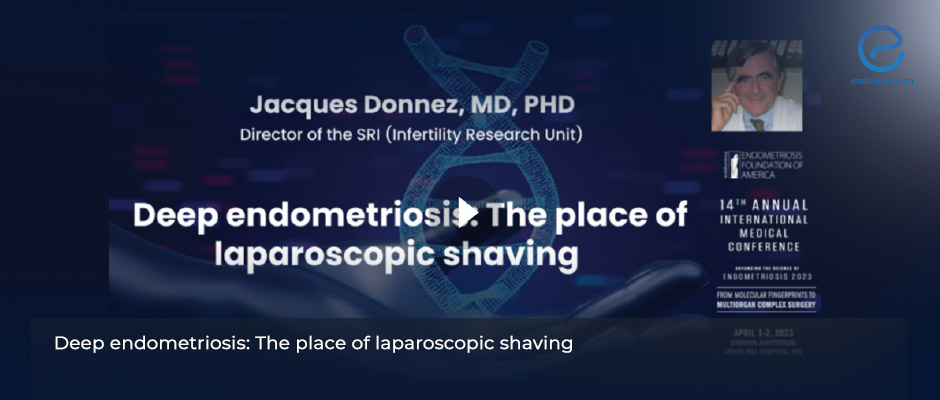Which surgery for deep endometriosis? Laparoscopic shaving or rectal resection?
May 5, 2023
The ideal rectal resection should be limited to cases with valid indications.
Key Points
Highlights:
- Dr. Jacques Donnez, the director of the infertility research unit at the Catholic University of Louvain, Brussels, Belgium, presented this keynote lecture at the Annual International Medical Conference of the Endometriosis Foundation of America held in New York on April 1-2, 2023.
- When the benefits and side effects of the two surgeries are compared, the superiority of the laparoscopic shaving technique over rectal resection is undeniable.
- The exceptions are occlusion of the rectum of more than 80%, the presence of multiple lesions on the sigmoid colon, and involvement of the posterior wall of the rectum.
Importance:
- The complications and the recurrence rate after the surgery are important obstacles to deep endometriosis surgery.
What's done here?
- Dr. Donnez discussed the indications, benefits, side effects, and pregnancy rates, comparing two types of deep endometriosis surgery which are laparoscopic shaving and rectal resection.
Outlines:
- The primary surgical approach for deep endometriosis located between the cervix and rectum should be laparoscopic shaving.
- The shaving procedure includes the separation of the rectum from the cervix to make a visible vaginal pouch, the dissection from the lower part of the nodule, and to check the integrity of the ureter.
- Excision of the endometriotic nodule from the rectal wall and the removal of the vaginal fornix is important milestones.
- If rectal wall dissection ends with the opening of the rectal lumen, the gynecologist should be skilled in repairing the wall. Fibering glue placed on these closing sutures will help wound healing.
- After the removal of the vaginal fornix patient would be relieved of her previous dyspareunia symptom.
- With the removal of the nodule from the rectal wall, the adverse effects of fibrotic tissue disappear, and the rectal lumen will expand over time to give a chance to relieve gastrointestinal symptoms.
Lay Summary
This keynote lecture entitled "Deep endometriosis: The place of laparoscopic shaving" was presented by Dr. Jacques Donnez, the director of the infertility research unit at the Catholic University of Louvain, Brussels, Belgium, at the Annual International Medical Conference of the Endometriosis Foundation of America held in New York on April 1-2, 2023.
The three localization types of "rectovaginal deep endometriosis" are the rectovaginal septum, fornix, and those originating from the posterior cervix ending to the rectum. The last one is called "hourglass shape " due to its vision in MR detection, and this localization of deep endometriosis is the main position that concerns laparoscopic shaving.
Instead of the definition as a "4-5 mm-sized nodule" in the rectovaginal area, the correct definition of deep endometriosis should be the "presence of a bigger than 1 cm-sized endometriotic nodule with a high majority of 2-4 cm in size" in the same area.
Dr. Donnez explained the steps of laparoscopic shaving surgery and compared the outcomes of this operation to rectal resection, which some clinics usually prefer as surgery for deep endometriosis. Dr. Donnez also pointed out the advantages of the shaving technique as superior to rectal resection, except for three criteria. These criteria are complete or more than 80% of rectal stenosis, multiple localization of endometriosis on the sigmoid colon associated with the rectal nodule, and posterior rectal invasion of endometriosis.
After rectal resection, rectovaginal fistulas, pelvic nerve damages, and unpleasant urinary and digestive symptoms are more common. The ideal rectal resection should be for a limited number of cases with valid indications. In their 500-case laparoscopic shaving series, the spontaneous pregnancy rate was 57%. Cases who could not conceive spontaneously and received up to 6 IVF cycles had a 64% pregnancy rate. Based on Dr. Donnez's experience, postoperative conceiving is recommended as soon as possible.
Research Source: https://www.endofound.org/keynote-deep-endometriosis-the-place-of-laparoscopic-shaving-jacques-donnez-md-phd?action=preview
laparoscopic shaving rectal resection dyspareunia pelvic pain vaginal fornix rectovaginal fistule IVF pregnancy rates deep endometriosis.

